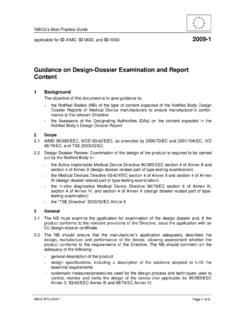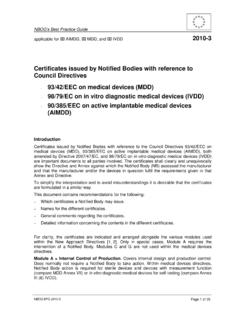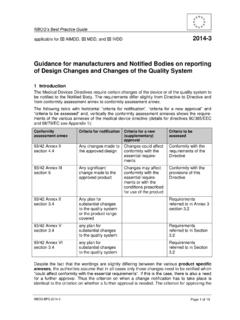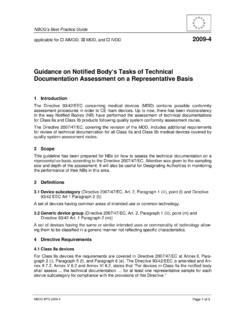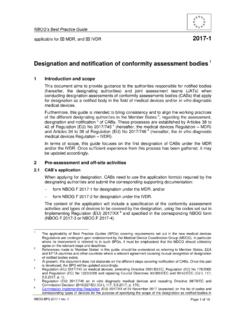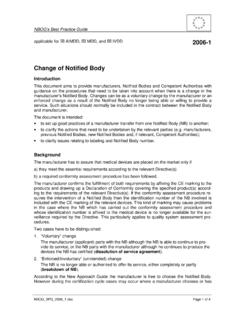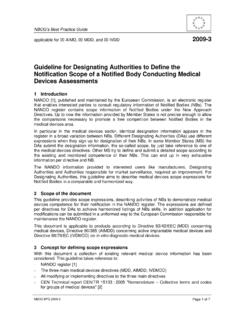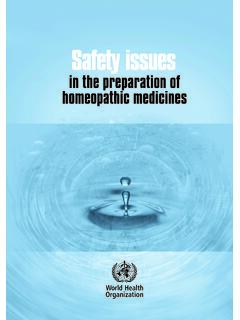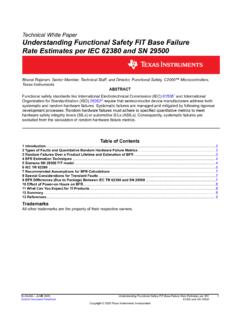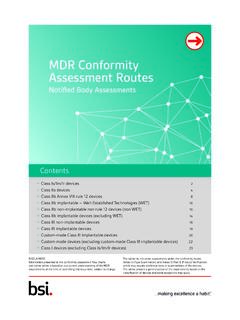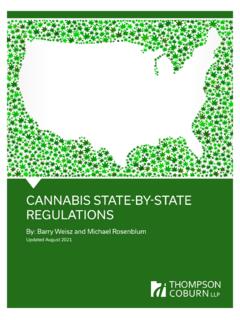Transcription of Guidance for Notified Bodies auditing suppliers to medical ...
1 NBOG s Best Practice Guide applicable for AIMDD, MDD, and IVDD 2010-1 NBOG BPG 2010-1 Page 1 of 7 Guidance for Notified Bodies auditing suppliers to medical device manufacturers 1 Introduction This document gives Guidance to Notified Bodies on auditing of a manufacturer s purchasing controls, including when and to what extent audits of suppliers are necessary. It also serves as Guidance to Designating Authorities assessing such Notified Body activities. The manufacturer that is ultimately responsible for the device also has full responsibility for each element of the quality management system (QMS). The manufacturer cannot relinquish (contractually or otherwise) the responsibility of any or all functions within the quality manage-ment system relating to a particular device. This includes elements such as customer com-plaints handling and vigilance. In effect, this means that the responsibility for complying with the QMS requirements cannot be delegated to any supplier of a product, and/or a service.
2 2 Definitions supplier Organisation or person that provides a product, a service or information, and which is outside of the QMS of the manufacturer [1]. Examples of supplier : Producer, distributor, retailer or vendor of a product, or provider of a service or information For the purpose of this document, the product supplied may be a process , a supplier may provide a sterilisation process. Note 1: For the purpose of this document, Note 1 of EN ISO 9000 does not apply Note 2: The term supplier may refer to a contractor or subcontractor . For the purposes of the document the terms are regarded as synonymous. Critical supplier A critical supplier is a supplier delivering materials, components, or services that may influence the safety and performance of the device [2]. Note: In the context of the audit of medical device manufacturers, a critical supplier is a sup-plier of a product or service, the failure of which to meet specified requirements could cause unreasonable risk to the patient, clinician or others, or could cause a significant degradation in performance.
3 This can include suppliers of services, which are needed for compliance with QMS or regulatory requirements, internal audit contractors or Authorised Representatives. NBOG s Best Practice Guide 2010-1 NBOG BPG 2010-1 Page 2 of 7 3 Legislative Basis for the requirements for suppliers Quality assurance systems Approvals of quality systems according to Annex II, V or VI of Directive 93/42/EEC, Annex 2 or 5 of Directive 90/385/EEC or Annex IV or VII of Directive 98/79/EC may only be issued if the Notified Body has verified and documented, evidence has been provided, that the quality system is able to ensure that the products conform to the provision of these Directives, which apply to them at every stage, from design to final inspection . The Notified Body shall include in its assessment all of the steps in the design and/or manufac-ture during product realisation of a medical device that are conducted by suppliers .
4 This includes the provision of raw materials, components and services. Annex II Section (b) of Directive 93/42/EEC states where the design, manufacture and/or final inspection and testing of the products, or elements thereof, is carried out by a third party, the methods of monitoring the efficient operation of the quality system and in particular the type and extent of control applied to the third party must be included in the manufacturer s applica-tion for assessment to the Notified Body. suppliers are examples of a third party . The Directives, Directive 93/42/EEC Annex II Section , state The assessment team must include at least one member with past experience of assessments of the technology con-cerned. The assessment procedure must include an assessment, on a representative basis, of the documentation of the design of the product(s) concerned, an inspection on the manufac-turer's premises and, in duly substantiated cases, on the premises of the manufacturer's suppli-ers to inspect the manufacturing processes.
5 The Notified Body therefore has to audit the activities and/or premises of suppliers linked to the specific medical devices (for further guid-ance please refer to section 5 of this document). However, in the conformity assessment procedure the Notified Body should consider the results of tests, assessments and audits, which have already been conducted for the relevant products. 4 Audit of the purchasing system of the manufacturer The manufacturer should establish and maintain documented procedures and records to ensure that products or services purchased from their suppliers meet the relevant regulatory require-ments. Purchasing controls will be first assessed by the Notified Body at the premises of the manufac-turer. Hereby, the Notified Body normally should use section of EN ISO 13485 [3] and applicable Guidance from the GHTF [4, 6] (extract from document N30 [4] is reproduced below).
6 N30 Purchasing Controls Subsystem The Purchasing Controls subsystem should be considered a main subsystem for those manufacturers who outsource essential activities such as design and development and/or production to one or more suppliers . Objective: The purpose of auditing the purchasing control subsystem is to verify that the manufacturer s processes ensure that products, components, materials and services provided by suppliers , (including contractors and consultants) are in conformity. This is particularly important when the finished product or service cannot be verified by inspec-tion ( sterilisation services). Major Steps: The following major steps serve as a guide in the audit of the Purchasing controls Subsystem. [The examples listed below of objective evidence were drawn from the flow chart in GHTF SG3 N17 Guidance on the control of products and services obtained from suppliers [5] (see Appendix 1)]: NBOG s Best Practice Guide 2010-1 NBOG BPG 2010-1 Page 3 of 7 1.
7 Verify that procedures for conducting supplier evaluations have been established. (ISO 13485:2003: ) Documented process/product controls for manufacturer and supplier supplier Management Procedures 2. Verify that the manufacturer evaluates and maintains effective controls over suppliers , so that specified requirements are met. (ISO 13485:2003: ) supplier selection criteria & decision rationale Competency of the selector of the supplier supplier agreements (see Appendix 2 for details) Change Management Methodology and Records 3. Verify that the manufacturer assures the adequacy of specifications for products and services that suppliers are to provide, and defines risk management responsibilities and any necessary risk control measures. (ISO 13485:2003: ) Specifications, requirements, procedures & work instructions Documented list of the risks identified for the products and services supplied, and linkage to design and planning Quality Requirements documented Capability assessment of the supplier Contracts, Purchase Orders 4.
8 Verify that records of supplier evaluations are maintained. (ISO 13485:2003: ) Audits Reports (1st, 2nd, & 3rd Party) Correspondence ( supplier File; Change control, audits, CAPAs) Minutes of Meetings with supplier CAPA relating to products and services supplied Verification of incoming products 5. Determine that the verification of purchased products and services is adequate. (ISO 13485:2003: ) Acceptance procedures for incoming products Specifications & Procedures Documented process/product controls for manufacturer and supplier Evaluate the Purchasing Controls subsystem for adequacy based on findings. 5 Criteria for audit of a supplier s premises The Notified Body auditors should determine and document the need to audit at a supplier s premises depending on: the outcome of the audit of the manufacturer s purchasing process (as outlined in Appendix 1) and other processes, described above. The Notified Body should have predefined decision criteria, which they use to decide, based on audit outcome if an audit of a particular supplier is required.
9 Information derived from the audit may include: information of the product realisation processes, including data from incoming acceptance activities and production controls whether the manufacturer performs an inspection on the product or service supplied whether faults in the product supplied can be detected at some later stage in production NBOG s Best Practice Guide 2010-1 NBOG BPG 2010-1 Page 4 of 7 whether the history/data relating to suppliers is sufficient whether there is third party certification of suppliers and whether this certification alone is adequate the criticality of the item or process being purchased, the effect the purchased product/service might have on the subsequent product realisation or the final product (GHTF SG3 N17/2008 [5], section ). Critical items or processes may include: Finished products Primary packaging Sterilisation Contract laboratories ( biocompatibility) Services (Design, Distribution, Regulatory Compliance etc.)
10 Labeling Other similar cases where the conformity of the finished medical device is significantly influenced by the activity of the supplier and the manufacturer cannot demonstrate sufficient control over the supplier via purchasing controls and incoming acceptance activities Note: It is the responsibility of the manufacturer to determine which are critical items or processes and how their purchase is controlled. This depends on the manufac-turer s risk management activity. However, the auditing organisation may decide to visit suppliers deemed by the manufacturer to be non-critical. In response to post market information Field safety Corrective actions impacting on the supplier s processes or products Complaints relating to the supplier s processes or products Post- market information, clinical investigations, public information etc., relating to the supplier s processes or products In principle, premises of critical suppliers should be audited.
